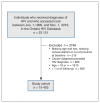The burden of cancer among people living with HIV in Ontario, Canada, 1997-2020: a retrospective population-based cohort study using administrative health data
- PMID: 35853661
- PMCID: PMC9312995
- DOI: 10.9778/cmajo.20220012
The burden of cancer among people living with HIV in Ontario, Canada, 1997-2020: a retrospective population-based cohort study using administrative health data
Abstract
Background: With combination antiretroviral therapy (ART) and increased longevity, cancer is a leading cause of morbidity among people with HIV. We characterized trends in cancer burden among people with HIV in Ontario, Canada, between 1997 and 2020.
Methods: We conducted a population-based, retrospective cohort study of adults with HIV using linked administrative health databases from Jan. 1, 1997, to Nov. 1, 2020. We grouped cancers as infection-related AIDS-defining cancers (ADCs), infection-related non-ADCs (NADCs) and infection-unrelated cancers. We calculated age-standardized incidence rates per 100 000 person-years with 95% confidence intervals (CIs) using direct standardization, stratified by calendar period and sex. We also calculated limited-duration prevalence.
Results: Among 19 403 adults living with HIV (79% males), 1275 incident cancers were diagnosed. From 1997-2000 to 2016- 2020, we saw a decrease in the incidence of all cancers (1113.9 [95% CI 657.7-1765.6] to 683.5 [95% CI 613.4-759.4] per 100 000 person-years), ADCs (403.1 [95% CI 194.2-739.0] to 103.8 [95% CI 79.2-133.6] per 100 000 person-years) and infection-related NADCs (196.6 [95% CI 37.9-591.9] to 121.9 [95% CI 94.3-154.9] per 100 000 person-years). The incidence of infection-unrelated cancers was stable at 451.0 per 100 000 person-years (95% CI 410.3-494.7). The incidence of cancer among females increased over time but was similar to that of males in 2016-2020.
Interpretation: Over a 24-year period, the incidence of cancer decreased overall, largely driven by a considerable decrease in the incidence of ADC, whereas the incidence of infection-unrelated cancer remained unchanged and contributed to the greatest burden of cancer. These findings could reflect combination ART-mediated changes in infectious comorbidity and increased life expectancy; targeted cancer screening and prevention strategies are needed.
© 2022 CMA Impact Inc. or its licensors.
Conflict of interest statement
Competing interests: Marek Smieja reports funding from the Canadian Institutes of Health Research, Air Canada and the Greater Toronto Airports Authority. No other competing interests were declared.
Figures



References
Publication types
MeSH terms
Grants and funding
LinkOut - more resources
Full Text Sources
Medical
